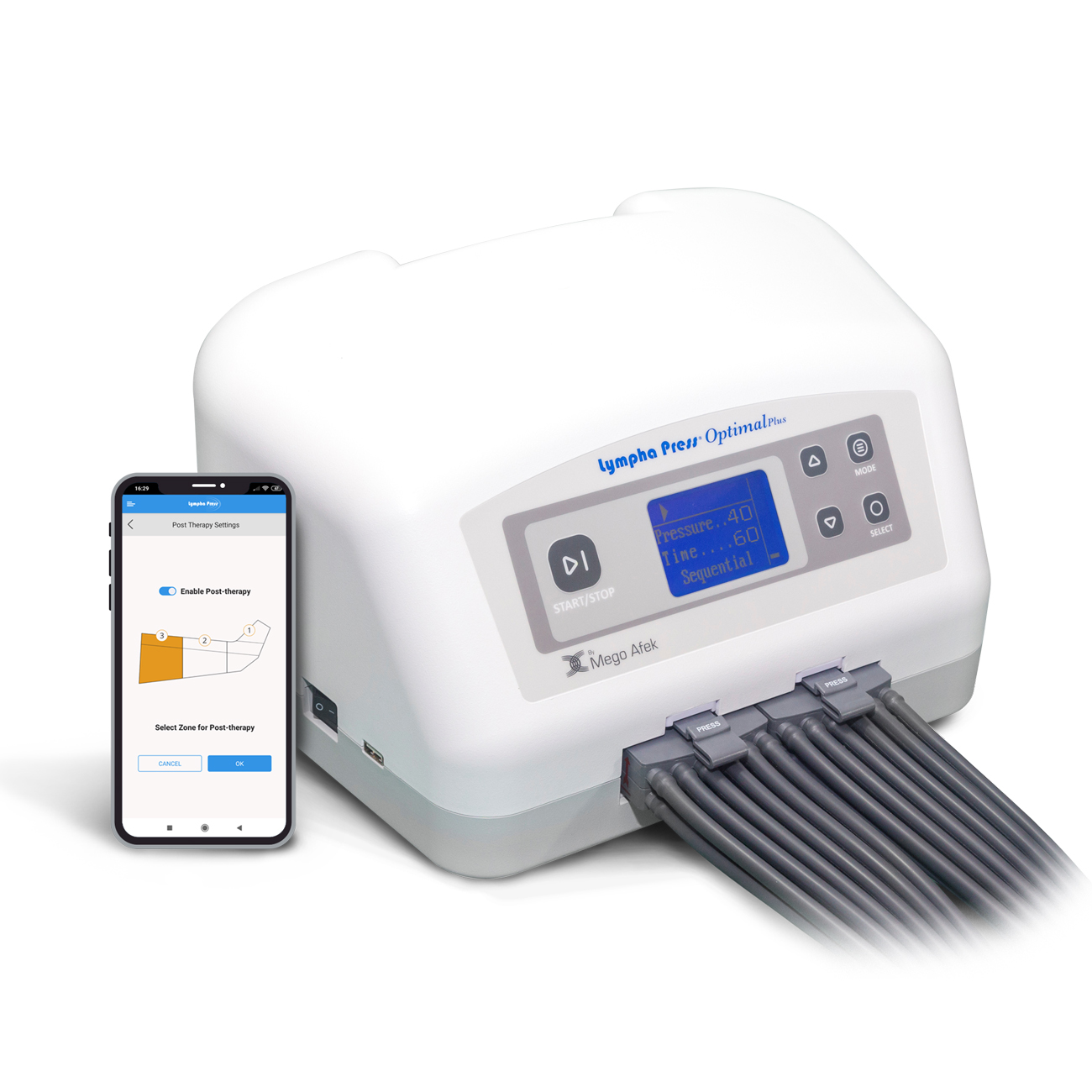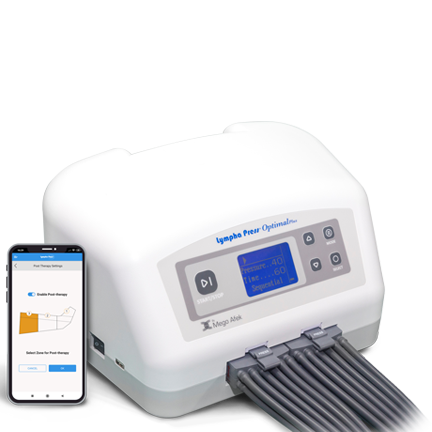
Lympha Press® is designed to keep therapy moving forward.
Ongoing management by clinicians of lymphedema and chronic venous insufficiency can have a huge impact on the daily lives of people experiencing these conditions. Having the right pneumatic compression therapy device can help your patients meet treatment goals, such as improved limb volume, pain reduction, improved vein/cavity wall integrity, and even reduced edema. The Lympha Press line of dynamic compression therapy systems is proven to give you better clinical outcomes with less effort and time on your part.
Why is Lympha Press so effective?
The advanced Lympha Press® Therapy System is designed to be reliable, safe and comfortable for your patients. We count on you to help your patients improve, so our system adapts to their progress with customization options and advanced programming capabilities.
Clinical Information
Conditions Treated
Proven to help patients return to their everyday activities more quickly and safely, Lympha Press technologies adapt to patients’ progress. Our pneumatic compression systems incorporate advanced technology design for ease-of-use, which contributes to high adherence rates and excellent outcomes.
Chronic Wounds
A common cause of Chronic Wounds is Chronic Venous Insufficiency (CVI), which affects 2 – 5% of the adult population in the United States. CVI can create the following symptoms:
- Pain and neuropathy
- Varicose veins
- Skin breakdown
- Venous stasis ulcers
- Breakdown of the lymphatic channels leading to edemaIt is also important to understand that when venous insufficiency occurs, reflux of blood back through the veins increases pressure on the venous-side of the capillary. This prevents the absorption of lymph and may also cause more lymph to expel into the interstitial tissue. In turn, the lymphatic system can only handle a finite amount of lymph, so it is clear that these systems impact each other greatly. The lymphatic system needs a properly functioning venous system to ensure the return of lymph back into the bloodstream. Likewise, the venous system cannot independently and adequately evacuate lymph from the interstitial tissues without a properly functioning lymphatic system.More simply stated, to effectively treat chronic wounds it is necessary to reduce edema, increase circulation and control infection. Patriot Medical Distributor’s Lympha Press® devices help to accomplish these three goals, and encourages wound healing at the wound base.
To connect with Arizona Vascular to learn how Lympha Press can help, Contact us.
Lymphedema
Lymphedema has been described as “a plumbing problem.” Not exactly medical jargon, but when you consider the role of the lymphatic system and what happens when it gets blocked up, it does seem to fit.
Lymphedema Defined:
“Lymphedema is the swelling of subcutaneous tissues due to the accumulation of excessive lymph fluid. The accumulation of lymph fluid results from impairment to the normal clearing function of the lymphatic system and/or from an excessive production of lymph.” (Medicare NCD – #280.6)
The Lymphatic System
Most of us are familiar with the circulatory system – the veins, arteries and capillaries that move blood to and from all the places in our body. The arteries carry oxygenated blood from the lungs, along with nutrients, to all the cells in the body. They end in capillaries that nourish the tissue. The capillaries then lead to the veins, which return the depleted blood back to the lungs.
The lymph vessels are also an important part of the circulatory system. As the blood flows through the capillaries, it is under pressure. Because of this pressure, fluid and proteins seep out of the arterial side of the capillaries. The tiny lymph capillaries pick up these lost fluids and proteins and transport them through progressively larger lymph vessels. As this “lymph fluid” flows through the lymph vessels, it is filtered through lymph nodes, where white blood cells remove bacteria and other foreign materials. The fluids are then returned to the bloodstream. We can think of the lymph vessels as the body’s “water system,” with “watersheds” where the smaller lymph vessels drain off directionally into bigger collectors, and “purification stations” at the lymph nodes.
Lymphedema
The amount of fluid processed by the lymphatic system is truly huge. At any one time, nearly 90% of the water found in our blood is being filtered through the lymphatic system. In cases of overload, such as injury or infection, healthy lymphatic vessels can absorb up to ten times their usual capacity. But when the lymphatic system is malformed or damaged, blockages can result. The lymphatic fluids from that particular area “serviced” by the blocked channel cannot be transported adequately. Excess fluids build up and produce swelling. In addition, the proteins that leach out of the arterial capillaries build up in this fluid, attracting even more water as the body seeks to maintain its osmotic balance. This causes further swelling. This condition is called lymphedema, and can appear in various parts of the body, but most often affects the arms or legs. The swelling can cause the affected limb to become extremely large and heavy, causing disfigurement and disability. Chronic inflammation causes fibrosis, a hardening of the surrounding tissues, making the drainage process even more difficult. The stagnant lymph fluid also provides ideal growing conditions for bacteria that lead to infection. So people with lymphedema must maintain a strict regimen of skin care, avoiding any wounds or abrasions that might allow entry to bacteria or other pathogens. People with lymphedema must be on guard for systemic infections such as cellulitis that can make them extremely ill.
Causes of lymphedema
Lymphedema can be caused by malformed or inadequate lymphatics – an inborn defect. In keeping with our “plumbing” theme, you can think of a faulty pipe system – not enough pipes, or pipes with the wrong shape or made from the wrong materials. This type of lymphedema is called primary lymphedema.
Primary lymphedema can be evident from birth, when the baby is born with a swollen arm or leg, or it can develop later in adolescence or even in adulthood. Congenital lymphedema appears at birth. Milroy’s disease is a familial, or inherited, form of congenital lymphedema. Lymphedema praecox appears before the age of 35, usually during adolescence. Primary lymphedema that appears after the age of 35 is calledlymphedema tarda.
Secondary lymphedema, sometimes called acquired lymphedema, is caused by blockage or disruption of the lymphatic vessels due to disease or trauma.
Examples of secondary lymphedema include those caused by mastectomy surgery and/or radiation (postmastectomy lymphedema); other surgeries, especially cancer surgeries with lymph node removal; tumors pressing or blocking the lymphatic vessels; trauma due to accidents, and occasionally as a result of liposuction surgery. Filariasis, a parasitic infection, is a frequent cause of secondary lymphedema in tropical countries.
Left untreated, lymphedema can cause serious complications, so it is extremely important that the patient receive effective and consistent treatment. Surgical methods are usually not recommended except in very specific situations. If lymphedema is caused by parasitic or other infections, medications may be prescribed. In general, treatment focuses on reducing the accumulation of lymphatic fluid.
To connect with Arizona Vascular to learn more about how Lympha Press therapy can effectively treat Lymphedema, Contact us.
Peripheral Arterial Disease
When cholesterol and other fats that circulate within the blood begin to build up or collect on the arterial wall, these fat deposits harden into plaque. This hardening process is called Atherosclerosis, derived from Greek words athero (meaning gruel or paste) and sclerosis (hardness).
Plaque formations can grow large enough to not only significantly reduce the blood’s flow through an artery but also create blockages. When leg arteries are hardened and clogged, blood flow to the legs and feet is reduced, resulting in pain, poor circulation and a variety of complications that can greatly impact quality of life.
The good news is that there is help for those suffering from PAD. Follow this link to connect with Arizona Vascular and learn how the ArtAssist® device can help.
Venous Insufficiency
Chronic venous insufficiency is caused by inadequate function of the one-way valves in the veins. When these valves lose their ability to close properly, the blood can flow backwards as well as forwards. This causes the veins to become swollen with blood. In addition, because they are so overfull, the veins lose their ability to pick up and transport interstitial fluid, and more fluid leaks out from the veins into the surrounding tissue. This is called venous edema. This extra fluid makes it difficult for the blood to nourish the tissues, and the tissue becomes inflamed and fragile. A small injury can lead to formation of an open wound, which does not heal – a venous stasis ulcer. The swelling keeps the borders of the wound apart – another barrier to healing.
Treatment
The cornerstone of treatment for chronic venous insufficiency is external compression. External compression works by pressing on the tissues and veins, reducing the diameter of the swollen vessels so that the blood inside them can flow more efficiently. Compression also assists in removing edema from the tissues.
There are various forms of external compression. Medical compression stockings are specially constructed to apply a gradient of pressure. Non-elastic static compression devices are also available. These are applied around the leg with straps to hold them in place.
Sequential compression for venous insufficiency
Lympha Press devices can be especially helpful for treating chronic venous insufficiency and healing venous stasis ulcers. Their active compression replicates the effect of normal walking, helps oxygenate the tissues, and removes edema, promoting healing of venous stasis ulcers. Removing the stagnant edema allows for better nourishment and oxygenation of the tissues, and reduces swelling which will allow the borders of the chronic wounds to close.
Our Lympha Press® devices have unique features that make them especially effective for the treatment of venous insufficiency:
- Rapid inflation time – means that the limb is under pressure for a shorter interval. This makes treatment more comfortable – especially for patients with painful wound beds.
- Calibrated gradient pressure1 – three to twelve pressure zones individually adjustable at the pump1, so that pressure can be adjusted over areas of focal discomfort.
- Multiple overlapping chamber system – for comfortable massage in smaller increments, without gaps.
- Adjustable pause time2 – increases the “rest” period between massage waves.2
Click here to connect with Arizona Vascular and learn how Lympha Press can help.
1 Models 1033. 1201 and 201Max only
2 Model 701 only
Our products can improve the quality of life for patients suffering from a variety of conditions.
Intermittent Claudication
Limb Salvage & CLI
Arteriogenesis
Not all pneumatic compression is the same.
One of our team members will work with you to help determine the best product for your patient’s condition.
We offer a total solutions approach to your patients.
Lympha Press compression therapy is a highly effective, easy-to-use treatment option. Compression garments are designed and manufactured to provide efficient treatment of lymphedema and lymphoedema – but not all pneumatic compression is the same. Lympha Press garments feature overlapping chambers in the garments to reduce backflow or gaps between chambers, making them more effective in managing your condition. Unlike many other products, Lympha Press also features an easy-to-clean material for added convenience
Pumps for Edema, Lymphedema, and Lipedema

